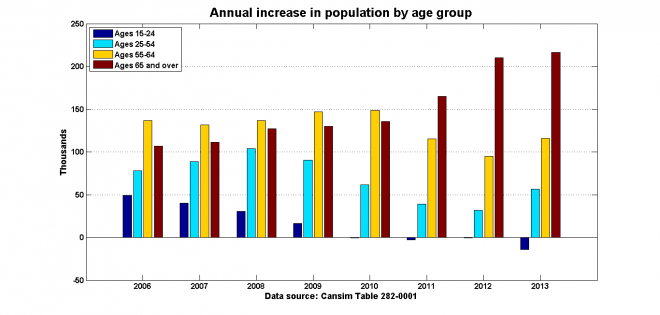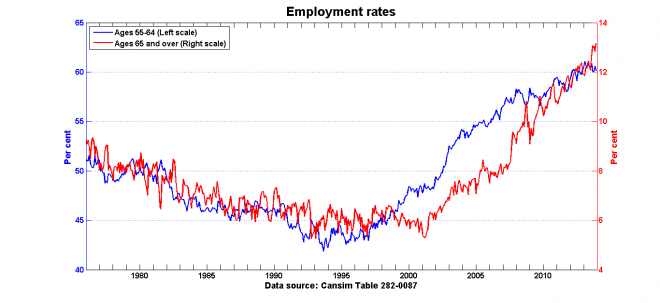An aging population requires a rethink of how we view the job market
The working age population is growing, and growing older
Paul Edmondson / Corbis
Share

This is a paragraph from Chris Sorenson’s recent cover story on the state of the Canadian labour market:
Is it any wonder critics are poking holes in the Harper government’s claims about all the jobs created since the recession? Jim Stanford, an economist with Unifor, the new union created by the merger of the Canadian Auto Workers and the Communications, Energy and Paperworkers, recently wrote in a report that the addition of more than one million jobs since 2009 is far less impressive, when one considers that Canada’s working-age population has grown by 350,000 people per year during that time – among the fastest in the developed world. In fact, the gradual decline in Canada’s unemployment rate has more to do with declining labour-market participation: Frustrated job-seekers who give up on their searches altogether are not counted in the official statistics. A better measure of job-market performance, Stanford argued, is the overall employment rate, which looks at how many working-age Canadians actually have jobs. That figure currently sits at 61.8 per cent, barely improved from the pit of the recession and below the level it was a decade ago. Without vigorous job growth that exceeds increases in the population, things aren’t going to get any better. “No wonder it still feels like a recession in the labour market,” Stanford notes. “By this key measure, we are hardly better off than during the darkest days of the financial crisis.”
Well, no. There are no doubt some discouraged workers who have left the labour force, but there’s another, far more compelling explanation for the declining participation rate: population aging. The working age population – here I too am using the measure published in the Labour Force Survey for those 15 years old and over, and which is used to calculate employment rates – is indeed increasing by about 350,000 people a year. But here is how that population increase is distributed across different age groups:
The leading edge of the baby boom generation was born in 1947 and reached retirement age two years ago; the wave of people aging into retirement has begun in earnest and will accelerate over the next few decades. Expressing those increases in age group populations as a fraction of the increase in the total population yields some startling statistics. The 65-and-over age group accounts full more than half of the growth in the working-age population over the past three years, and the 55-and-over age group accounts for almost 90 per cent. I find these numbers so astonishing that I’m going to repeat them in bold italics:
The 65-and-over age group accounts for more than half of the growth in the working-age population over the past three years
The 55-and-over age group accounts for almost 90 per cent of the growth in the working-age population over the past three years
Not all of these workers are leaving the labour force out of frustration. In fact, the employment rates in these groups is increasing:
But these increases have not been strong enough to compensate for the fact that labour force participation rates drop rapidly as people approach and pass the age of 65. A better measure of the strength of the labour market is the employment rate of the ‘prime’ working-age population, namely those between 25 and 54 years of age:
The employment rate of the prime working-age population fell from its peak of 82.6 per cent to 80.0 per cent, and notwithstanding the disappointing data for December, it has recovered most of that loss and is now 81.4 per cent. Not yet a full recovery, but certainly much better than the ‘darkest days of the financial crisis.’
Paul Krugman noted the effects of population aging on employment rates more than a year ago, and he suggested a rough-and-ready correction by using constant weights for the age group-specific employment rates. I reproduced this exercise for Canadian data on Econowatch here, under the counterfactual scenario in which the relative size of the age groups remained constant. This graph updates the exercise, using the population weights for October 2008, the pre-recession employment peak:
The constant population weight measure shows a significant recovery, even as the reported measure – which assigns ever-increasing weights to older age groups – is going sideways.
Population aging is changing the labour force, and it’s also changing the way we should be looking at employment data.
[Update: The charts and the numbers have been updated from the original post to reflect the December 2013 Labour Force Survey release.]



